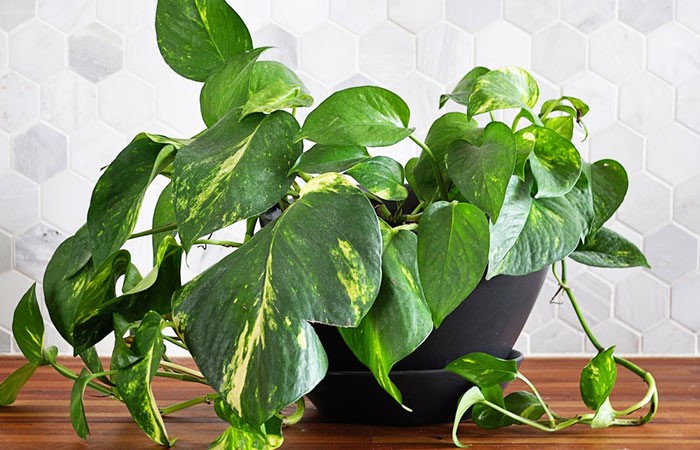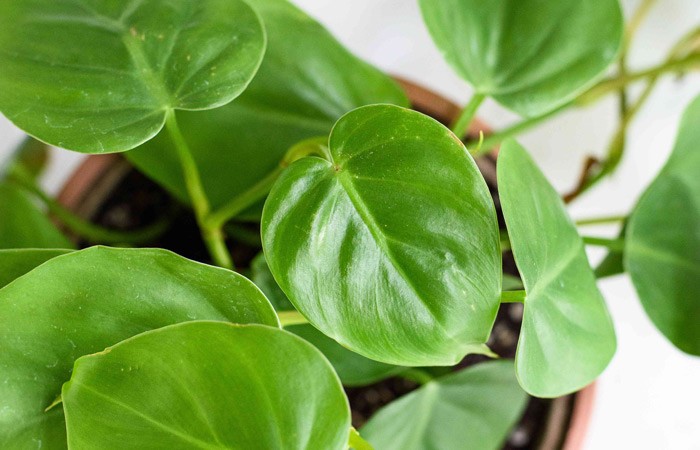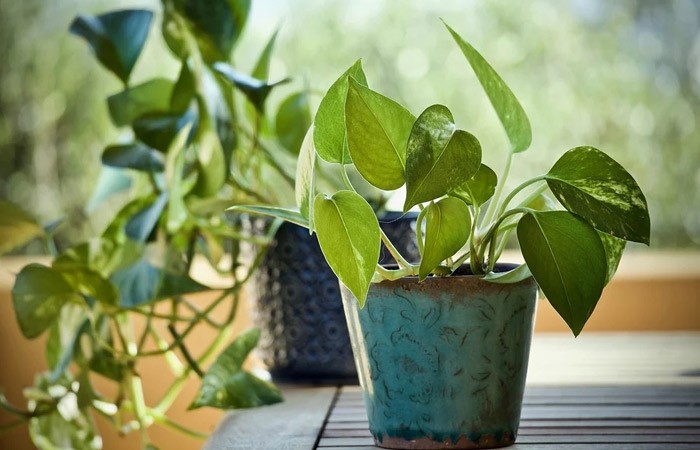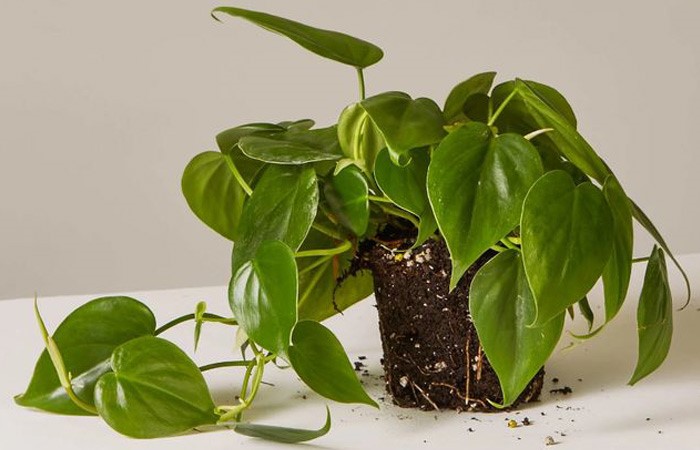Pothos vs Philodendron: How to Tell the Difference

When it comes to Pothos vs Philodendron, there are not a lot of people who can distinguish these plants from one another. Although Pothos and Philodendron both have many similarities, both in appearance and requirements, they are different hose plants and have unique needs.
Here, we are going to compare Philodendron vs Pothos from different points of view to understand the differences between Pothos and Philodendron better.
Pothos vs Philodendron; Is It Important?
Philodendron and Pothos have green and sometimes variegated leaves on their vines that can climb from structures. They are also similar in size and being low maintenance. Sometimes even the retailers mislabel Pothos and Philodendron. So why is comparing Philodendron vs Pothos important?
The most important reason is to have information regarding Pothos vs Philodendron care. To have a vibrant house plant, you need to know exactly what its requirements are. Overall, pothos care is more convenient than philodendron care. Botanical curiosity is another reason to be interested in Pothos vs Philodendron.
In the next parts, we will take a closer look at the differences between Pothos and Philodendron to recognize them better.

Pothos and Philodendron Plant Taxonomy
With the scientific name of Epipremnum aureum, people often call Pothos varieties as Devil’s Ivy, Money Plant, Snake Plant, Mother in Law’s Tongue, or Silver Vine. In addition to these names, sometimes it is listed as Scindapsus aureus too.
Scindapsus aureus is a scientific synonym for Pothos varieties, but it is not the official scientific name. So if you ever wondered about Scindapsus vs Pothos, there is your answer.
Like Pothos varieties, Philodendron hederaceum (or simply Philodendrons) is a large and diverse genus of plants. You have probably seen it under the synonym Philodendron scandens as well. People often confuse this plant, especially the Heartleaf Philodendron or sweetheart plant, with Pothos.
Pothos and Philodendron are related and from the family, Araceae. However, Pothos varieties are in the genus Epipremnum, and types of philodendron are in the genus Philodendron.
Philodendron vs Pothos Leaves
The similarity between the leaves of these popular houseplants is one of the reasons that some people cannot tell Philodendron and Pothos apart. Different Philodendron and Pothos varieties can make identifying difficult, but there are clear differences in Pothos vs Philodendron when it comes to their leaves.
Texture
When comparing Pothos vs Philodendron, at the first glance, Philodendron has a matte-like finish that absorbs light but Pothos leaves have a glossy glow.
Types of philodendron leaves have a smooth surface with a velvety feel and are thinner. On the other hand, Pothos varieties leaves are thicker and have a slightly raised surface with some texture, and the look and feel of being slightly waxed. They also have an apparent ridge down the center midrib that types of philodendron lack.
Shape
Normally, different types of philodendron are more rounded and heart-shaped with longer tips that look like a spout. On the other hand, Pothos varieties leaves have a more irregular shape with shorter and less pointed tips.
Cataphyll
Another difference in Philodendron vs Pothos leaves is the cataphyll, a specialized sheath on leaves. Cataphyll grows from a stem node and protects each emerging leaf. Between Pothos and Philodendron, only the latter has this leaf protection.
In fact, the cataphyll is a modified leaf that remains on the stem for a short time while the real leaf unfolds. Eventually, it turns thin and brown before drying up and falling off. Pothos varieties do not have this part, and the new leaves simply unfold from older ones.

Pothos and Philodendron New Growth
The color of new growth can also help you in comparing Philodendron vs Pothos. In types of philodendron, new leaves typically have different foliage than the plant itself. The color of new growth in this houseplant has a brownish, reddish, or pink tint. This color variance can be more notable in some varieties.
Pothos varieties do not have this luxury in their new foliage. Pothos’ new leaves are a shade lighter than the original but never show an entirely different color.
Devil’s Ivy vs. Philodendron Petiole
It is not difficult to spot the differences in the petiole concerning Pothos vs Philodendron. As you know, the petiole is the part that attaches a leaf to the vine.
Philodendron has a round and uniform petiole which is usually brown or a shade lighter than the leaves. Pothos varieties have an indented ridge parallel with the leaf stem. Pothos petiole thicker too, with a color similar or slightly lighter than the foliage.
Philodendron and Pothos Aerial Roots
Pothos and Philodendron both have aerial roots. They sprout from leaf nodes and grow above the soil. These roots are able to absorb moisture and nutrients along the stems.
Aerial roots are the part that allows Philodendron and Pothos to climb different structures and anchor for support. Keep in mind that aerial roots are aggressive roots, attaching themselves to any rough surface. So if you do not want your plant to climb, keep it contained to avoid dark root marks on your wall or furniture after removing them.
The notable thing in Pothos vs Philodendron regarding these roots is that Neon Pothos and other types of these plant has limited aerial roots (one root per node) that are actually small, thick nubs. Types of philodendron’s aerial roots are not as limited, and you can even consider them as a small root system. Emerging in groups of two to six, they are thinner than those of Pothos varieties.
Tip: Do not prune aerial roots during the high-growth period, as they normally respond by multiplying. The offseason is the best time for trimming them.

Pothos vs Philodendron Care
Like many others, Pothos vs Philodendron care could be the only important difference between Pothos and Philodendron. As low-maintenance houseplants, they have very similar requirements when it comes to soil, water, temperature, and light requirements, with minor differences that are good to know.
Below, we are going to review Pothos vs Philodendron care to know their requirements more precisely.
Pothos Care
Pothos varieties enjoy bright, indirect light more than types of philodendron do. However, since we are talking about a durable ad adapting houseplant, Pothos care is possible in low light locations too.
Brazil Pothos and other varieties of this plant do not tolerate direct sun. But comparing Pothos vs Philodendron care, once again Pothos performs better in this case. This is because it can take more intensity than a Philodendron without sunburns. Marble Queen Pothos and other types of Pothos handle drought and hot weather better too.
What you need to remember about Pothos’ care is that it does not like cold temperatures. So do not water it with frigid water to avoid shocking its roots.
Philodendron Care
In Pothos vs Philodendron care, Philodendron thrives better in lower light conditions, and hold their variegation better in such locations. Philodendron propagation is easier when comparing Philodendron vs Pothos too.
They also tolerate cold weather better, although stop growing in cold environments and cannot survive frost. In Philodendron’s care, remember that they are less vulnerable to stress from cooler temperatures than a Pothos as well.

Pothos vs Philodendron Varieties
When comparing Philodendron vs Pothos, recognizing the botanical differences between Philodendron and Pothos could be especially beneficial.
Interestingly, there is another closely-related popular plant that can make things when comparing Pothos vs Philodendron: Satin Pothos. This plant is actually a Scindapsus pictus, and in a different genus from both Philodendron hederaceum and Epipremnum aureum. This can also answer questions about Scindapsus vs Pothos.
Although Satin Pothos has a lot of similarities to both Philodendron and Pothos, the particular leaf pattern of this plant makes it really easy to identify.
Pothos Varieties
You can find both variegated pothos and variegated Philodendron. Nevertheless, Pothos offers more forms. The most popular is the Neon Pothos (Which technically is a Golden Pothos).
Among the different variations of this charming houseplant, even the almost green Jade Pothos offers striking cream patches. The Marble Queen Pothos features impressive shattered variegation as well.
You should place epipremnum aureum in a location with indirect light so they can maintain their variegation. In darker locations, they tend to go back to all-green leaves to increase photosynthesis.
Types of Philodendron
Similar to Pothos variations, Philodendrons have some cultivars as well; but with less variegation among them. Ace of Spades is without doubt one of the most unusual varieties, with leaves that have reddish-orange dark undersides.
Ace of Spades is actually less similar to a standard Philodendron than a common Pothos.
Eventually, variegated forms of Philodendrons look crisper and maintain their color better than Pothos in locations with lower light.
Can you tell the difference between Pothos vs Philodendron now? They look really similar at first glance, but you can easily identify them with various key features.
Apart from the differences that we mentioned, it is worth noting that both of these gorgeous houseplants are excellent choices to buy and grow. In addition, they can act as living air-purifiers.
They remove toxins including benzene, formaldehyde, and trichloroethylene from the atmosphere around them with no sound.
- In this post:
- Pothos vs Philodendron; Is It Important?
- Pothos and Philodendron Plant Taxonomy
- Philodendron vs Pothos Leaves
- Pothos and Philodendron New Growth
- Devil’s Ivy vs. Philodendron Petiole
- Philodendron and Pothos Aerial Roots
- Pothos vs Philodendron Care
- Pothos vs Philodendron Varieties



